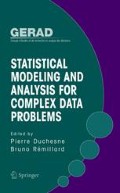Abstract
In this paper, we provide a review of some recent results for ARMA models with uncorrelated but non independent errors. The standard so-called Box-Jenkins methodology rests on the errors independence. When the errors are suspected to be non independent, which is often the case in real situations, this methodology needs to be adapted. We study in detail the main steps of this methodology in the above-mentioned framework.
Access this chapter
Tax calculation will be finalised at checkout
Purchases are for personal use only
Preview
Unable to display preview. Download preview PDF.
References
Andrews, D.W.K. (1991). Heteroskedasticity and autocorrelation consistent covariance matrix estimation. Econometrica, 59:817–858.
Béguin, J.M., Gouriéroux, C., and Monfort, A. (1980). Identification of a mixed autoregressive-moving average process: The corner method. In: Anderson, O.D. (ed.), Time Series, pages 423–436, North-Holland, Amsterdam.
Berk, K.N. (1974). Consistent autoregressive spectral estimates. The Annals of Statistics, 2:489–502.
Berlinet, A. (1984). Estimating the degrees of an ARMA model. Compstat Lectures, 3:61–94.
Berlinet, A. and Francq, C. (1997). On Bartlett's Formula for nonlinear processes. Journal of Time Series Analysis, 18:535–55.
Berlinet, A. and Francq, C. (1999). Estimation des covariances entre autocovariances empiriques de processus multivariés non linéaires. The Canadian Journal of Statistics, 27:1–22.
Billingsley, P. (1995). Probability and Measure. Wiley, New York.
Box, G.E.P. and Pierce, D.A. (1970). Distribution of residual autocorrelations in autoregressive-integrated moving average time series models. Journal of the American Statistical Association, 65:1509–1526.
Brockwell, P.J. and Davis, R.A. (1991). Time Series: Theory and Methods. Springer-Verlag, New York.
Broze, L., Francq, C., and Zakoïan, J-M. (2002). Efficient use of higher-lag autocorrelations for estimating autoregressive processes, Journal of Time Series Analysis, 23:287–312.
Carrasco, M. and Chen, X. (2002). Mixing and moment properties of various GARCH and stochastic volatility models. Econometric Theory, 18:17–39.
Dickey, D.A. and Fuller, W.A. (1979). Distribution of the estimators for autoregressive time series with a unit root. Journal of the American Statistical Association, 74:427–431.
Dunsmuir, W. and Hannan, E.J. (1976). Vector linear time series models. Advances in Applied Probability, 8:339–364.
Francq, C. and Zakoïan, J-M. (1998a). Estimating linear representations of nonlinear processes. Journal of Statistical Planning and Inference, 68:145–165.
Francq, C. and Zakoïan, J.-M. (1998b). Estimating the order of weak ARMA models. Prague Stochastic'98 Proceedings, 1:165–168.
Francq, C. and Zakoïan, J.-M. (2000). Covariance matrix estimation for estimators of mixing Wold's ARMA. Journal of Statistical Planning and Inference, 83:369–394.
Francq, C. and Zakoïan, J.-M. (2003). The L2-structures of standard and switching-regime GARCH models. Working document.
Francq, C., Roy R., and Zakoïan, J.-M. (2004). Diagnostic checking in ARMA models with uncorrelated errors. To appear in Journal of the American Statistical Association.
Glasbey, C.A. (1982). Generalization of partial autocorrelation useful in identifying ARMA models. Technometrics, 24:223–228.
Hannan, E.J. (1973). The asymptotic theory of linear time series models. Journal of Applied Probability, 10:130–145.
Hansen, B.E. (1992). Consistent covariance matrix estimation for dependent heterogeneous processes. Econometrica, 60:967–972.
Hansen, L.P. (1982) Large sample properties of generalized method of moments estimators. Econometrica, 50:1029–1054.
Herrndorf, N. (1984). A functional central limit theorem for weakly dependent sequences of random variables. The Annals of Probability, 12:141–153.
Imhof, J.P. (1961). Computing the distribution of quadratic forms in normal variables. Biometrika, 48:419–426.
Kokoszka, P.S. and Taqqu, M.S. (1996). Parameter estimation for infinite variance fractional ARIMA. The Annals of Statistics, 24:1880–1913.
Ljung, G.M. and Box, G.E.P. (1978). On the Measure of lack of fit in time series models. Biometrika, 65:297–303.
Lobato, I.N. (2001). Testing that a dependent process is uncorrelated. Journal of the American Statistical Association, 96:1066–1076.
Mann, H.B. and Wald, A. (1943). On the statistical treatment of linear stochastic differential equations. Econometrica, 11:173–200.
Mélard, G. and Roy, R. (1987). On confidence intervals and tests for autocorrelations. Computational Statistics and Data Analysis, 5:31–44.
Mélard, G., Paesmans, M., and Roy, R. (1991). Consistent estimation of the asymptotic covariance structure of multivariate serial correlations. Journal of Time Series Analysis, 12:351–361.
Mikosch, T., Gadrich, T., Klüppelberg, C., and Adler, R.J. (1995). Parameter estimation for ARMA models with infinite variance innovations. The Annals of Statistics, 23:305–326.
Pham, D.T. (1986). The mixing property of bilinear and generalized random coefficient autoregressive models. Stochastic Processes and their Applications, 23:291–300.
Rissanen, J. and Caines, P.E. (1979). The strong consistency of maximum likelihood estimators for ARMA processes. The Annals of Statistics, 7:297–315.
Romano, J.L. and Thombs, L.A. (1996). Inference for autocorrelations under weak assumptions. Journal of the American Statistical Association, 91:590–600.
Roy, R. (1989). Asymptotic covariance structure of serial correlations in multivariate time series. Biometrika, 76:824–827.
Tiao, G.C. and Tsay, R.S. (1983). Consistency properties of least squares estimates of autoregressive parameters in ARMA models. The Annals of Statistics, 11:856–871.
Tong, H. (1990). Non-linear Time Series: A Dynamical System Approach. Clarendon Press Oxford.
Walker, A.M. (1964). Asymptotic properties of least squares estimates of the parameters of the spectrum of a stationary non-deterministic time series. Journal of the Australian Mathematical Society, 4:363–384.
Wold, H. (1938). A Study in the Analysis of Stationary Time Series. Almqvist and Wiksell, Stockholm.
Editor information
Editors and Affiliations
Rights and permissions
Copyright information
© 2005 Springer Science+Business Media, Inc.
About this chapter
Cite this chapter
Francq, C., Zakoïan, JM. (2005). Recent Results for Linear Time Series Models with Non Independent Innovations. In: Duchesne, P., RÉMillard, B. (eds) Statistical Modeling and Analysis for Complex Data Problems. Springer, Boston, MA. https://doi.org/10.1007/0-387-24555-3_12
Download citation
DOI: https://doi.org/10.1007/0-387-24555-3_12
Publisher Name: Springer, Boston, MA
Print ISBN: 978-0-387-24554-6
Online ISBN: 978-0-387-24555-3
eBook Packages: Mathematics and StatisticsMathematics and Statistics (R0)

